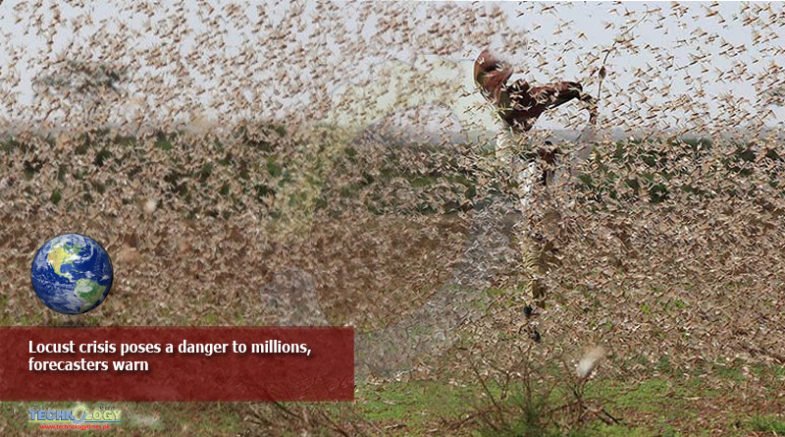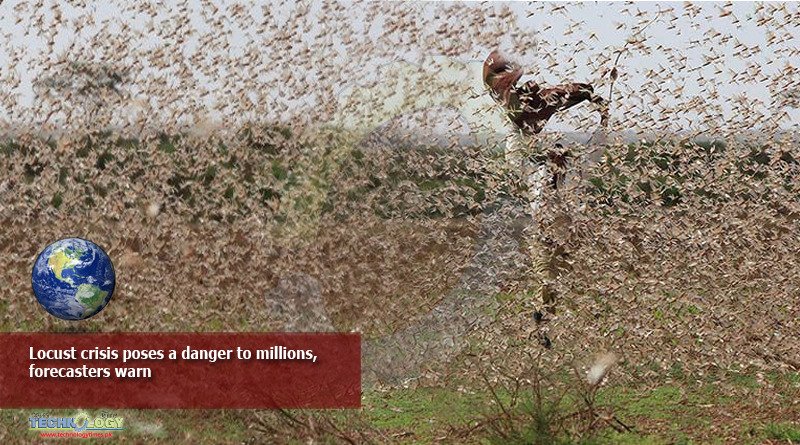The locust crisis that has now reached 10 countries could carry on to endanger millions more people, forecasters have said.Climate change created unprecedented conditions for the locusts to breed in the usually barren desert of the Arabian gulf, according to experts.

The insects were then able to spread through Yemen, where civil war has devastated the ability to control locust populations. It was Cyclone Mekunu, which struck in 2018, that allowed several generations of desert locusts the moist sand and vegetation to thrive in the desert between Saudi Arabia, Yemen and Oman known as the Empty Quarter, breeding and forming into crop-devouring swarms, said Keith Cressman, locust forecasting expert for the UN’s Food and Agriculture Organization (FAO).Advertisement
“That’s fine, that’s quite good in itself, but just about when those conditions are drying out and the breeding is coming to an end, a second cyclone came to the area,” he said.
“That allowed the conditions to continue to be favourable and another generation of breeding, so instead of increasing 400-fold, they increased 8,000-fold.
“Usually a cyclone brings favourable conditions for about six months and then the habitat dries out, and so it’s not favourable for reproduction and they die and migrate.”
The amount of cyclones in the area seem to be increasing, said Cressman, making it likely that locust swarms will also become more common.
The FAO has warned that the food security of 25 million people could be endangered by the locusts, which according to the agency’s locust monitoring service have been spotted in at least 10 countries over recent months. One swarm recently reported in Kenya covered an area the size of Luxembourg.
The organisation has requested $140m (£120m) to help fight the ongoing breeding of the insects, predicting that a continuation through late March and April could see the existing number of locusts grow by 400 times by June.
The current crisis is considered the worst in decades, and there are fears it could last longer than previous locust outbreaks.
Alongside the climate emergency impact, the war in Yemen is a key factor.
Cressman said Yemen is a “frontline” country for locusts, with the insects typically present throughout the year. But its once effective locust programme no longer has the same impact in cities where control is now divided between the government and Houthi rebels.
The head of the locust programme, Adel al-Shaibani, is based in the Houthi-controlled capital, Sana’a.
“Before the war we had a good ability to reach anywhere in Yemen,” he said. “In current times we’re just able to cover the Red Sea coastal areas – but not all – and some areas in the interior.”
He explained that there were two separate locust control centres in Yemen but neither was able to combat the outbreak effectively alone.
The Sana’a-based centre carried out control operations wherever they could in 2018, but they have been underfunded and have lost some of their vehicles.
“In spite of all our hard efforts, some areas remained out of control due to security reasons near the border with Saudi Arabia. The desert locust outbreak occurred and some swarms formed and moved to other areas,” said Shaibani.
By late 2019, the locusts had moved into the Horn of Africa, finding favourable conditions when an unseasonaal cyclone hit Somalia in December. This extended breeding time and allowed them to spread to areas authorities could not control because of the country’s security problems.
“This crisis could be quite long because of the Yemeni and Somali areas that cannot control the populations,” said Cyril Piou, an expert with the French Agricultural Research Centre for International Development.Advertisement
He said that in previous decades locust outbreaks had only lasted roughly two years but, without preventive systems, they will last longer, happen more frequently and spread further.
“We are all linked in some way, what is happening somewhere else affects us all,” he said.
The last comparable locust outbreak was in the late 1940s and 50s, but Cressman said that was in a time when monitoring and reporting was a slow, cumbersome process and chemical pesticides were readily available for control operations.
Historically, the Arabian Gulf has very few cyclones. But the past decade has brought a significant increase thanks to the Indian Ocean dipole, a phenomenon linked to flooding in the western Indian Ocean, dry weather in the east and wildfires in Australia.
Cressman, part of whose job involves looking at historical conditions to understand current developments, said the climate’s behavioural changes made that difficult.
“This analogous forecasting methodology used to work pretty good up until five years ago, and it’s just not working very well any more at all because of the rainfall, the timing, the distribution. It’s very different,” he said.
We’ve got an announcement…
… on our progress as an organisation. In service of the escalating climate emergency, we have made an important decision – to renounce fossil fuel advertising, becoming the first major global news organisation to institute an outright ban on taking money from companies that extract fossil fuels.
In October we outlined our pledge: that the Guardian will give global heating, wildlife extinction and pollution the urgent attention and prominence they demand. This resonated with so many readers around the world. We promise to update you on the steps we take to hold ourselves accountable at this defining point in our lifetimes. With climate misinformation rife, and never more dangerous than now, the Guardian’s accurate, authoritative reporting is vital – and we will not stay quiet.
You’ve read 12 articles in the last four months. We chose a different approach: to keep Guardian journalism open for all. We don’t have a paywall because we believe everyone deserves access to factual information, regardless of where they live or what they can afford to pay.
Our editorial independence means we are free to investigate and challenge inaction by those in power. We will inform our readers about threats to the environment based on scientific facts, not driven by commercial or political interests. And we have made several important changes to our style guide to ensure the language we use accurately reflects the environmental emergency.
The Guardian believes that the problems we face on the climate crisis are systemic and that fundamental societal change is needed. We will keep reporting on the efforts of individuals and communities around the world who are fearlessly taking a stand for future generations and the preservation of human life on earth. We want their stories to inspire hope.
We hope you will consider supporting us today. We need your support to keep delivering quality journalism that’s open and independent. Every reader contribution, however big or small, is so valuable.
Courtesy: Theguardian.com
